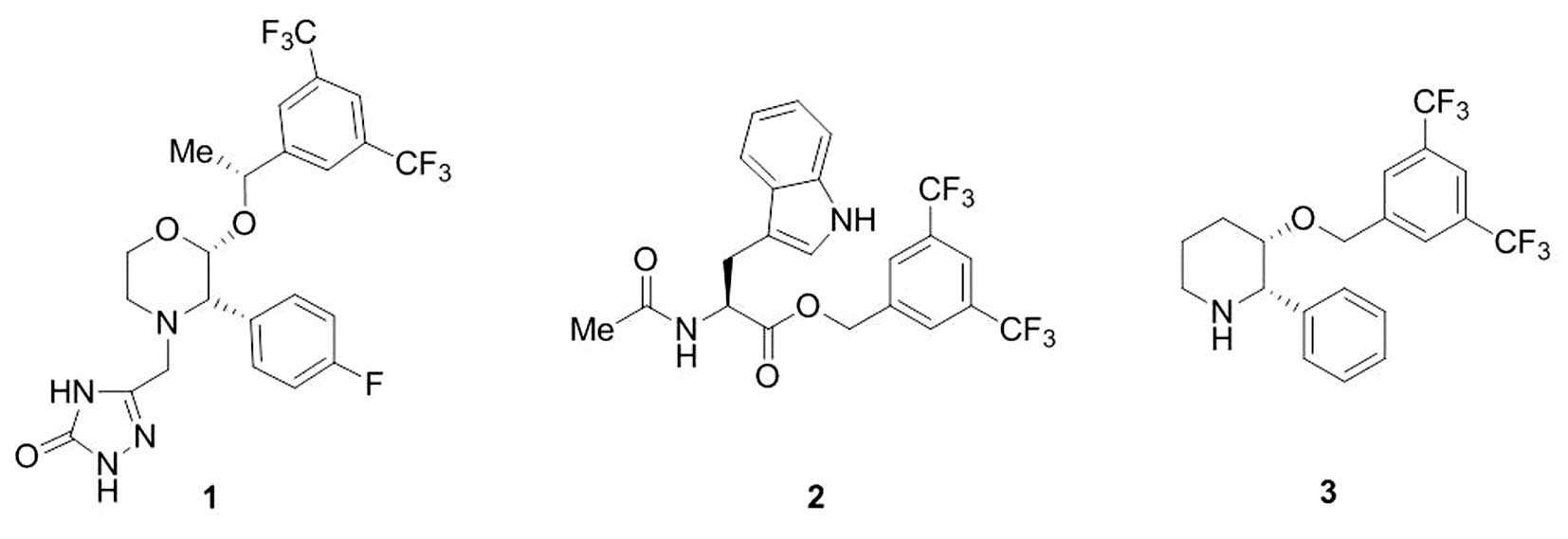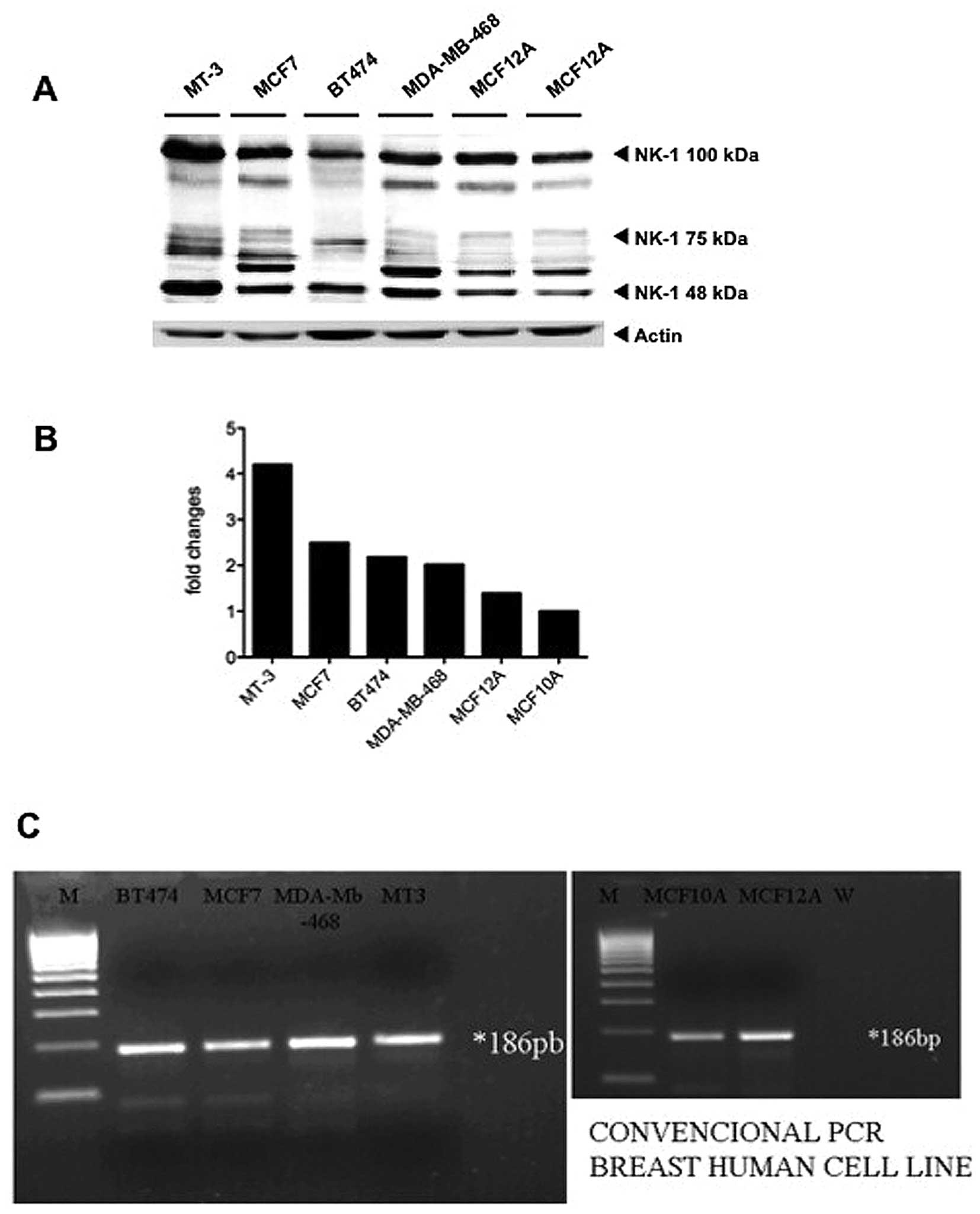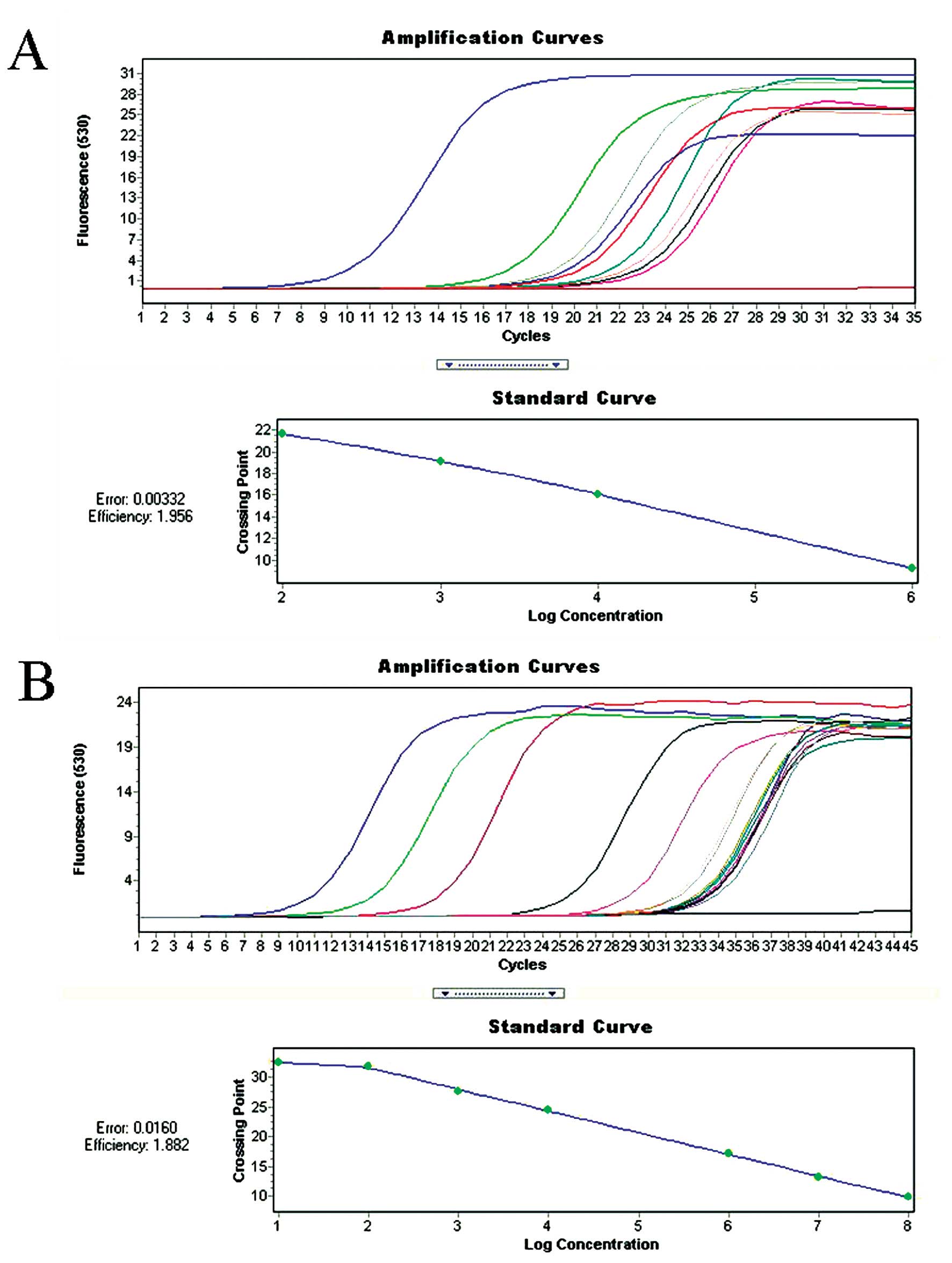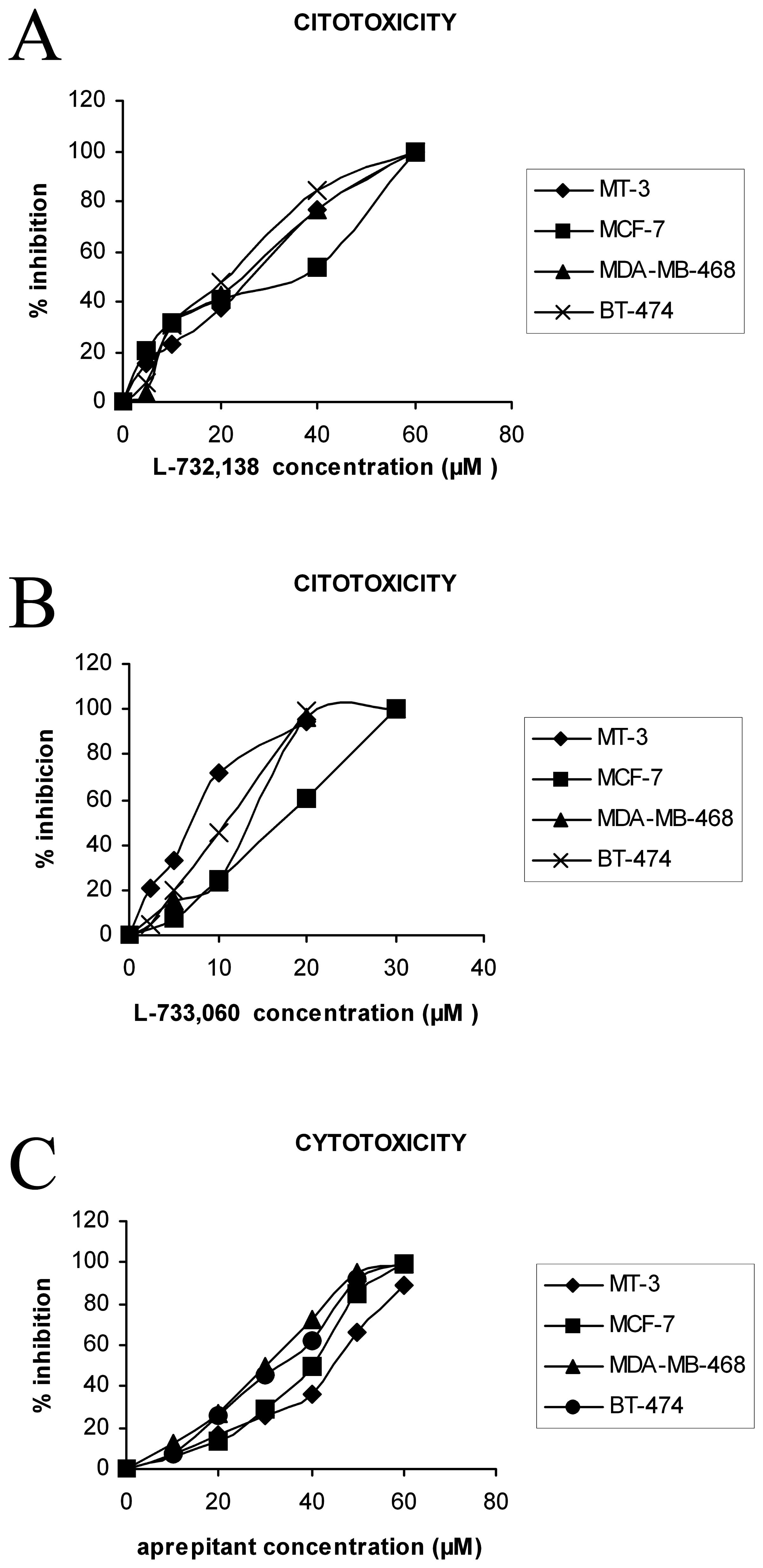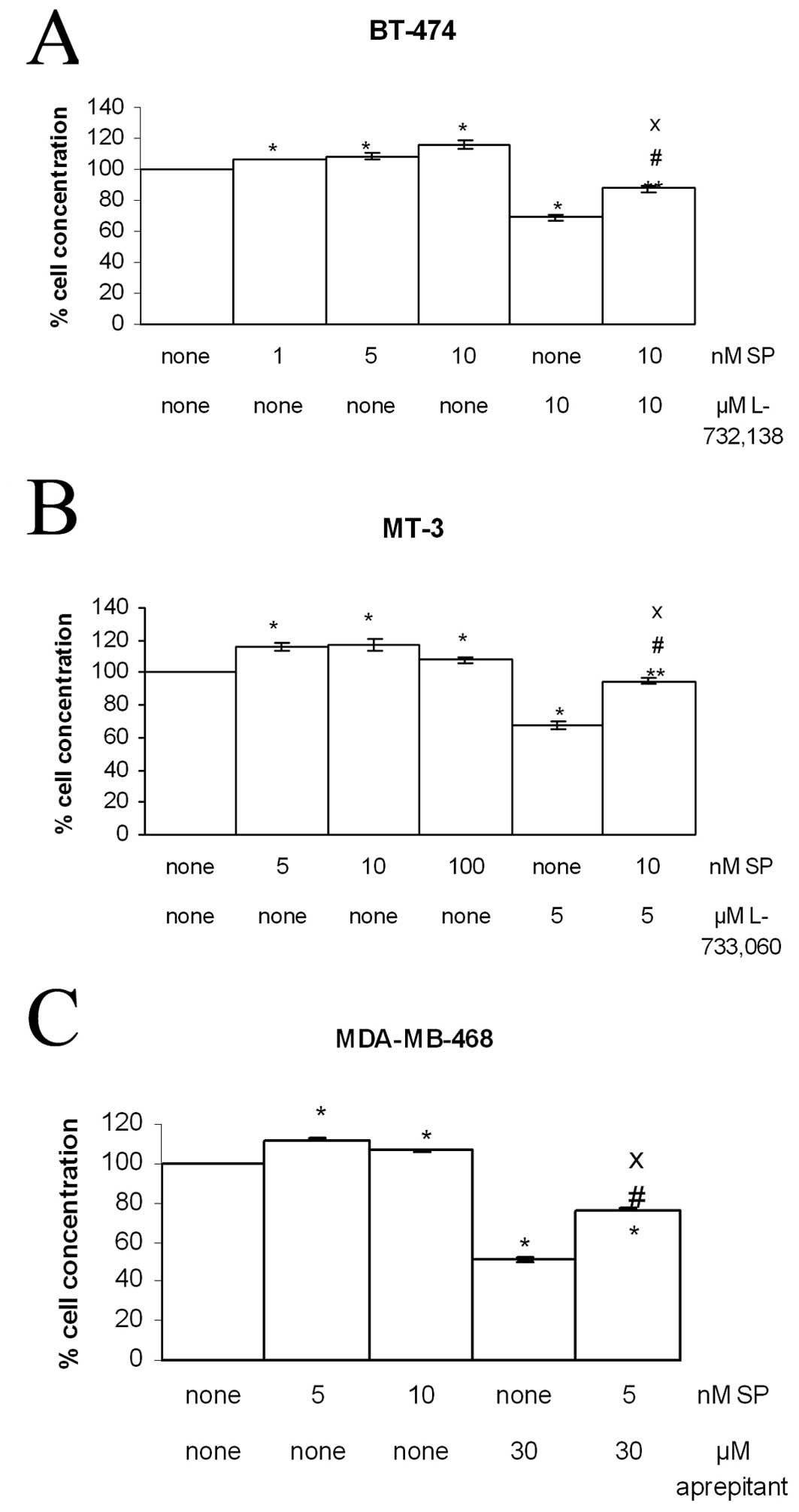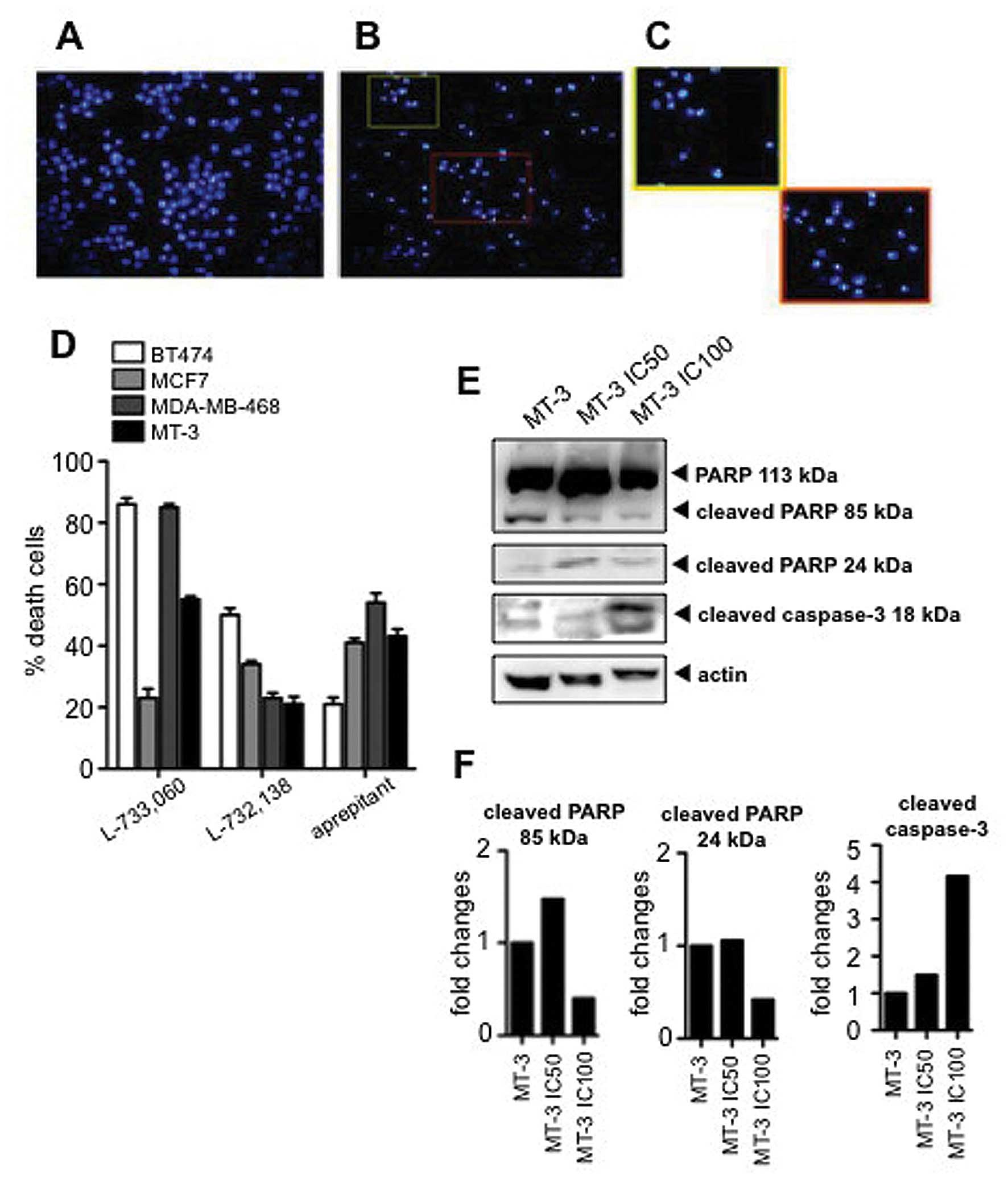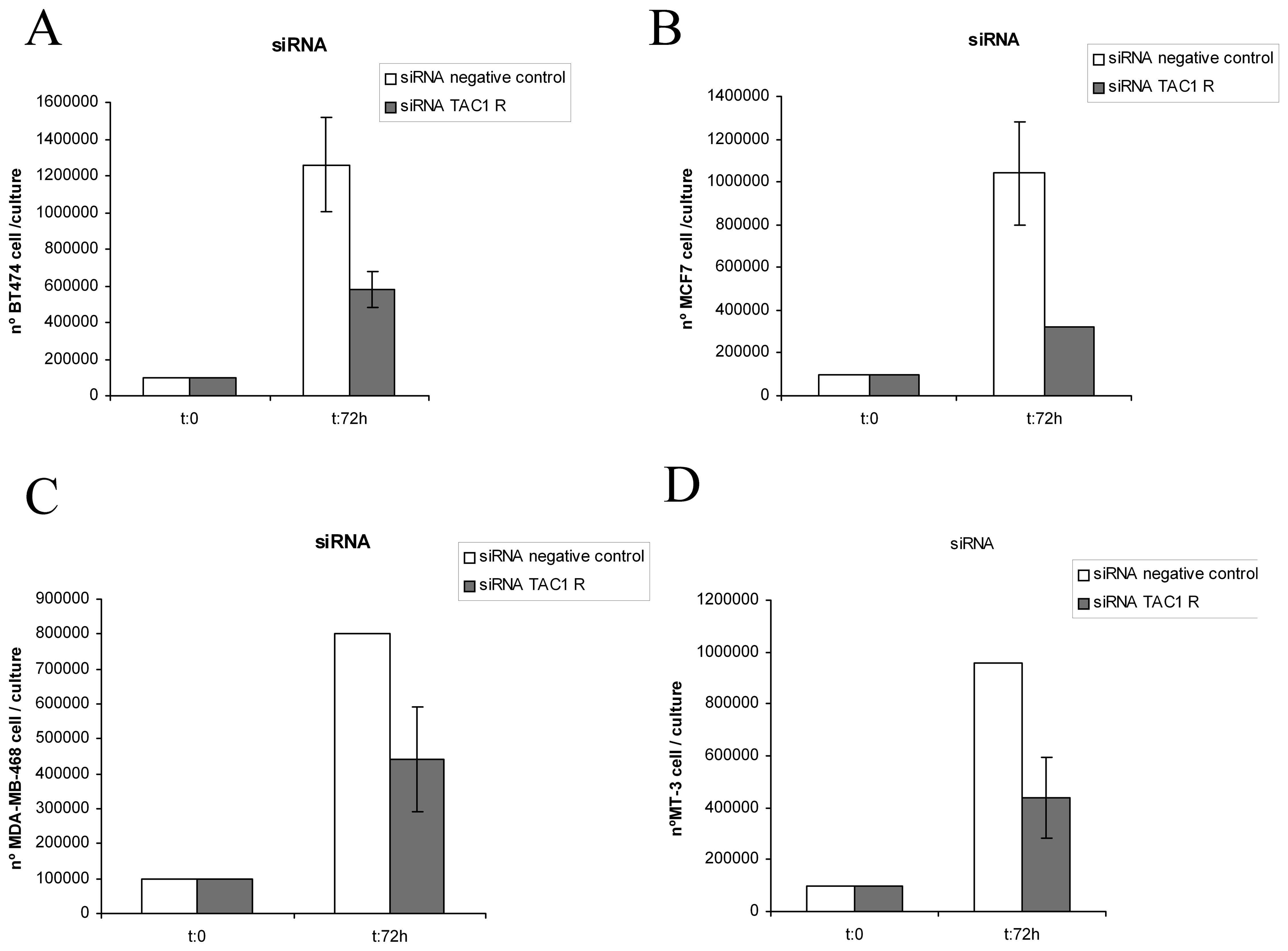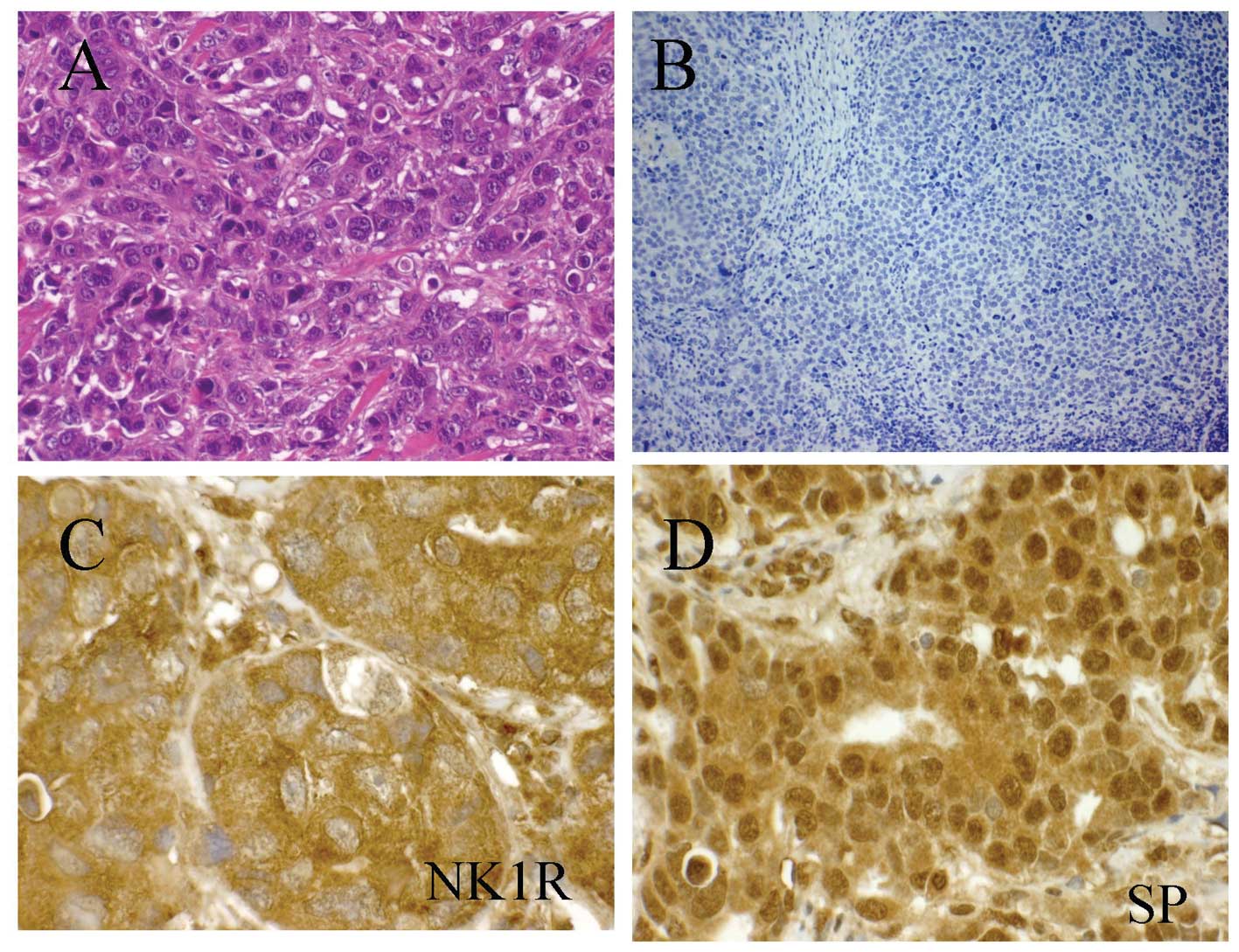|
1
|
Ahmedin J, Freddie B, Melissa M, Jacques
F, Elizabeth W and David F: Global cancer statistics. CA Cancer J
Clin. 61:69–90. 2011. View Article : Google Scholar
|
|
2
|
Muñoz M, Rosso M and Coveñas R: The NK-1
receptor: a new target in cancer therapy. Curr Drug Targets.
12:909–921. 2011.PubMed/NCBI
|
|
3
|
Muñoz M, Rosso M and Coveñas R: A new
frontier in the treatment of cancer: NK-1 receptor antagonists.
Curr Med Chem. 17:504–516. 2010.PubMed/NCBI
|
|
4
|
Muñoz M and Coveñas R: NK-1 receptor
antagonists: a new paradigm in pharmacological therapy. Curr Med
Chem. 17:504–513. 2011.PubMed/NCBI
|
|
5
|
Muñoz M, Rosso M, Casinello F and Coveñas
R: Paravertebral anesthesia: how substance P and the NK-1 receptor
could be involved in regional block and breast cancer recurrence.
Breast Cancer Res Treat. 122:601–603. 2010.PubMed/NCBI
|
|
6
|
Mancino M, Ametller E, Gascón P and
Almendro V: The neuronal influence on tumor progression. Biochim
Biophys Acta. 1816:105–118. 2011.PubMed/NCBI
|
|
7
|
Muñoz M, Berger M, Rosso M, et al:
Antitumor activity of neurokinin-1 receptor antagonists in MG-63
human osteosarcoma xenografts. Int J Oncol. 44:137–146.
2014.PubMed/NCBI
|
|
8
|
Berger M, Neth O, Ilmer M, et al:
Hepatoblastoma cells express truncated neurokinin-1 and can be
growth inhibited by aprepitant in vitro and in vivo. J Hepatol.
60:985–994. 2014. View Article : Google Scholar : PubMed/NCBI
|
|
9
|
Singh D, Joshi DD, Hameed M, et al:
Increased expression of preprotachykinin-I and neurokinin receptors
in human breast cancer cells: implications for bone marrow
metastasis. Proc Natl Acad Sci USA. 97:388–393. 2000. View Article : Google Scholar : PubMed/NCBI
|
|
10
|
Huang WQ, Wang JG, Chen L, Wei HJ and Chen
H: SR-140,333 counteracts NK-1 mediated cell proliferation in human
breast cancer cell line T47D. J Exp Clin Cancer Res. 29:55–62.
2010. View Article : Google Scholar : PubMed/NCBI
|
|
11
|
Bigioni M, Benzo A, Irrissuto C, Maggi CA
and Goso C: Role of NK-1 and NK-2 tachykinin receptor antagonism on
the growth of human breast carcinoma cell line MDA-MB-231.
Anticancer Drugs. 16:1083–1089. 2005. View Article : Google Scholar : PubMed/NCBI
|
|
12
|
Patel HJ, Ramkissoon SH, Patel PS and
Rameshwar P: Transformation of breast cells by truncated
neurokinin-1 receptor is secondary to activation by
preprotachykinin-A peptides. Proc Natl Acad Sci USA.
102:17436–17441. 2005. View Article : Google Scholar : PubMed/NCBI
|
|
13
|
Friess H, Zhu Z, Liard V, et al:
Neurokinin-1 receptor expression and its potential effects on tumor
growth in human pancreatic cancer. Lab Invest. 83:731–742. 2003.
View Article : Google Scholar : PubMed/NCBI
|
|
14
|
Luo W, Sharif TR and Sharif M: Substance
P-induced mitogenesis in human astrocytoma cells correlates with
activation of the mitogen-activated protein kinase signaling
pathway. Cancer Res. 56:4983–4991. 1996.
|
|
15
|
Esteban F, González-Moles MA, Castro D, et
al: Expression of substance P and neurokinin-1-receptor in
laryngeal cancer: linking chronic inflammation to cancer promotion
and progression. Histopathology. 54:258–260. 2009. View Article : Google Scholar : PubMed/NCBI
|
|
16
|
Muñoz M, González-Ortega A and Coveñas R:
The NK-1 receptor is expressed in human leukemia and is involved in
the antitumor action of aprepitant and other NK-1 receptor
antagonists on acute lymphoblastic leukemia cell lines. Invest New
Drugs. 30:529–540. 2010.PubMed/NCBI
|
|
17
|
Muñoz M, Pérez A, Rosso M, Zamarriego C
and Rosso R: Antitumoural action of NK1 receptor antagonist
L-733,060 on human melanoma cell lines. Melanoma Res. 14:183–188.
2004.PubMed/NCBI
|
|
18
|
Muñoz M, Rosso M, Aguilar FJ, et al: NK-1
receptor antagonists induce apoptosis and counteract substance
P-related mitogenesis in human laryngeal cancer cell line HEp-2.
Invest New Drugs. 26:111–118. 2008.PubMed/NCBI
|
|
19
|
Esteban F, Muñoz M, González-Moles MA and
Rosso M: A role for substance P in cancer promotion and
progression: a mechanism to counteract intracellular death signals
following oncogene activation or DNA damage. Cancer Metast Rev.
25:137–145. 2006. View Article : Google Scholar : PubMed/NCBI
|
|
20
|
Muñoz M and Rosso M: The NK-1 receptor
antagonist aprepitant as a broad spectrum antitumor drug. Invest
New Drugs. 28:187–193. 2010.PubMed/NCBI
|
|
21
|
Palma C, Bigioni M, Irrissuto C, et al:
Anti-tumour activity of tachykinin NK1 receptor antagonists on
human glioma U373 MG xenograft. Br J Cancer. 82:480–487.
2000.PubMed/NCBI
|
|
22
|
Palma C, Nardelli F, Manzini S and Maggi
CA: Substance P activates responses correlated with tumour growth
in human glioma cell lines bearing tachykinin NK1 receptors. Br J
Cancer. 79:236–243. 1999. View Article : Google Scholar : PubMed/NCBI
|
|
23
|
Muñoz M, Rosso M, Robles-Frías MJ, et al:
The NK-1 receptor is expressed in human melanoma and is involved in
the antitumor action of the NK-1 receptor antagonist aprepitant on
melanoma cell lines. Lab Invest. 90:1259–1269. 2010.
|
|
24
|
Mayordomo C, García-Recio S, Ametller E,
et al: Targeting of substance P induces cancer cell death and
decreases the steady state of EGFR and Her2. J Cell Physiol.
227:1358–1366. 2011. View Article : Google Scholar : PubMed/NCBI
|
|
25
|
Ziche M, Morbidelli L, Pacini M, et al:
Substance P stimulates neovascularization in vivo and proliferation
of cultured endothelial cells. Microvasc Res. 40:264–278. 1990.
View Article : Google Scholar : PubMed/NCBI
|
|
26
|
Lang K, Drell TL, Lindecke A, et al:
Induction of a meta-statogenic tumor cell type by neurotransmitters
and its pharmacological inhibition by established drugs. Int J
Cancer. 112:231–238. 2004. View Article : Google Scholar : PubMed/NCBI
|
|
27
|
Fan TP, Hu DE, Guard S, Gresham GA and
Watling KJ: Stimulation of angiogenesis by substance P an
interleukin-1 in the rat and its inhibition by NK1 or interleukin-1
receptor antagonists. Br J Pharmacol. 110:43–49. 1993. View Article : Google Scholar
|
|
28
|
Seegers HC, Hood VC, Kidd BL, Cruwys SC
and Walsh DA: Enhancement of angiogenesis by endogenous substance P
release and neurokinin-1 receptors during neurogenic inflammation.
J Pharmacol Exp Ther. 306:8–12. 2003. View Article : Google Scholar : PubMed/NCBI
|
|
29
|
Muñoz M, Bernabeu-Wittel J and Coveñas R:
NK-1 as a melanoma target. Expert Opin Ther Targets. 15:889–897.
2011.
|
|
30
|
Muñoz M, Rosso M, Pérez A, et al: The NK-1
receptor is involved in the antitumoural action of L-733,060 and
the mitogenic action of substance P on neuroblastoma and glioma
cell lines. Neuropeptides. 39:427–432. 2005.PubMed/NCBI
|
|
31
|
Brener S, González-Moles MA, Tostes D, et
al: A role for the substance P/NK-1 receptor complex in cell
proliferation in oral squamous cell carcinoma. Anticancer Res.
29:2323–2329. 2009.PubMed/NCBI
|
|
32
|
Moneo V, Serelde BG, Leal JFM, et al:
Levels of p27kip1 determine Aplidin sensitivity. Mol
Cancer Ther. 6:1310–1316. 2007.
|
|
33
|
Tansky MF, Pothoulakis C and Leeman SE:
Functional consequences of alteration of N-linked glycosylation
sites on the neurokinin-1 receptor. Proc Natl Acad Sci USA.
104:10691–10696. 2007. View Article : Google Scholar : PubMed/NCBI
|
|
34
|
González Moles MA, Mosqueda-Taylor A,
Esteban F, et al: Cell proliferation associated with actions of the
SP/NK-1 receptor complex in keratocystic odontogenic tumours. Oral
Oncol. 44:1127–1133. 2008.PubMed/NCBI
|
|
35
|
Muñoz M, Rosso M and Coveñas R: The NK-1
receptor is involved in the antitumoural action of L-733,060 and in
the mitogenic action of substance P on human pancreatic cancer cell
lines. Lett Drug Des Discov. 3:323–329. 2006.PubMed/NCBI
|
|
36
|
Rosso M, Robles-Frías MJ, Coveñas R,
Salinas-Martín MV and Muñoz M: The NK-1 receptor is involved in the
antitumor action of L-733,060 and in the mitogenic action of
substance P on human gastrointestinal cancer cell lines. Tumor
Biol. 29:245–254. 2008. View Article : Google Scholar : PubMed/NCBI
|
|
37
|
Muñoz M, Rosso M, Coveñas R, et al:
Neurokinin-1 receptors located in human retinoblastoma cell lines:
antitumor action of its antagonists, L-732,138. Invest Ophthalmol
Vis Sci. 48:2775–2781. 2007.PubMed/NCBI
|
|
38
|
Hennig IM, Laissue JA, Horisberger U and
Reubi JC: Substance-P receptors in human primary neoplasms: tumor
and vascular localization. Int J Cancer. 61:786–792. 1995.
View Article : Google Scholar : PubMed/NCBI
|
|
39
|
Zhou Y, Zhao L, Xiong T, et al: Roles of
full-length and truncated neurokinin-1 receptors on tumor
progression and distant metastasis in human breast cancer. Breast
Cancer Res Treat. 140:49–61. 2013. View Article : Google Scholar : PubMed/NCBI
|
|
40
|
Muñoz M, Rosso M, Pérez A, et al:
Antitumor action of the neurokinin-1-receptor antagonist L-733,060
and mitogenic action of substance P on human retinoblastoma cell
lines. Invest Ophthalmol Vis Sci. 46:2567–2570. 2005.PubMed/NCBI
|
|
41
|
Muñoz M, Rosso M, González-Ortega A and
Coveñas R: The NK-1 receptor antagonist L-732,138 induces apoptosis
and counteracts substance P-related mitogenesis in human melanoma
cell lines. Cancers. 2:611–623. 2010.PubMed/NCBI
|
|
42
|
Dimri R, Sharabi Y and Shoham J: Specific
inhibition of glucocorticoid thymocyte apoptosis by substance P. J
Immunol. 164:2479–2486. 2000. View Article : Google Scholar : PubMed/NCBI
|
|
43
|
Hilakivi-Clarke L, Rowland J, Clarke R and
Lippman ME: Psychosocial factors in the development and progression
of breast cancer. Breast Cancer Res Treat. 29:141–160. 1994.
View Article : Google Scholar : PubMed/NCBI
|
|
44
|
De Vane CL: Substance P: a new era, a new
role. Pharmacotherapy. 21:1061–1069. 2001.
|
|
45
|
Muñoz M, Pavón A, Rosso M, et al:
Immunolocalization of NK-1 receptor and substance P in human normal
placenta. Placenta. 31:649–651. 2010.PubMed/NCBI
|
|
46
|
Guha S, Eibl G, Kisfalvi K, et al:
Broad-spectrum G protein-coupled receptor antagonist,
[D-Arg1,DTrp5,7,9,Leu11]SP: a dual inhibitor of growth and
angiogenesis in pancreatic cancer. Cancer Res. 65:2738–2745.
2005.
|
|
47
|
Arslan Aydemir E, Simsek Oz E, Fidan
Korcum A and Fiskin K: Endostatin enhances radioresponse in breast
cancer cells via alteration of substance P levels. Oncol Lett.
2:879–886. 2011.PubMed/NCBI
|
|
48
|
Jemal A, Murray T, Samuels A, et al:
Cancer statistics, 2003. CA Cancer J Clin. 53:5–26. 2003.
View Article : Google Scholar
|
|
49
|
Mundy GR: Metastasis to bone: causes,
consequences and therapeutic opportunities. Nat Rev Cancer.
2:584–593. 2002. View
Article : Google Scholar : PubMed/NCBI
|
|
50
|
Rao G, Patel GS, Idler SP, et al:
Facilitating role of preprotachykinin- I gene in the integration of
breast cancer cells within the stromal compartment of the bone
marrow: a model of early cancer progression. Cancer Res.
64:2874–2881. 2004. View Article : Google Scholar : PubMed/NCBI
|
|
51
|
Meshki J, Douglas SD, Lai JP, et al:
Neurokinin 1 receptor mediates membrane blebbing in HEK293 cells
through a Rho/Rho-associated coiled-coil kinase dependent
mechanism. J Biol Chem. 284:9280–9289. 2009. View Article : Google Scholar : PubMed/NCBI
|
|
52
|
Fackler OT and Grosse R: Cell motility
through plasma membrane blebbing. J Cell Biol. 181:879–884. 2008.
View Article : Google Scholar : PubMed/NCBI
|
|
53
|
DeFea KA, Vaughn ZD, O’Bryan EM, et al:
The proliferative and antiapoptotic effects of substance P are
facilitated by formation of a beta-arrestin-dependent scaffolding
complex. Proc Natl Acad Sci USA. 97:11086–11091. 2000. View Article : Google Scholar : PubMed/NCBI
|
|
54
|
Akazawa T, Kwatra SG, Goldsmith LE, et al:
A constitutively active form of neurokinin 1 receptor and
neurokinin 1 receptor-mediated apoptosis in glioblastomas. J
Neurochem. 109:1079–1086. 2009. View Article : Google Scholar : PubMed/NCBI
|
|
55
|
García-Recio S, Fuster G,
Fernández-Nogueira P, et al: Substance P autocrine signaling
contributes to persistent HER2 activation that drives malignant
progression and drug resistance in breast cancer. Cancer Res.
73:6424–6434. 2013.PubMed/NCBI
|



